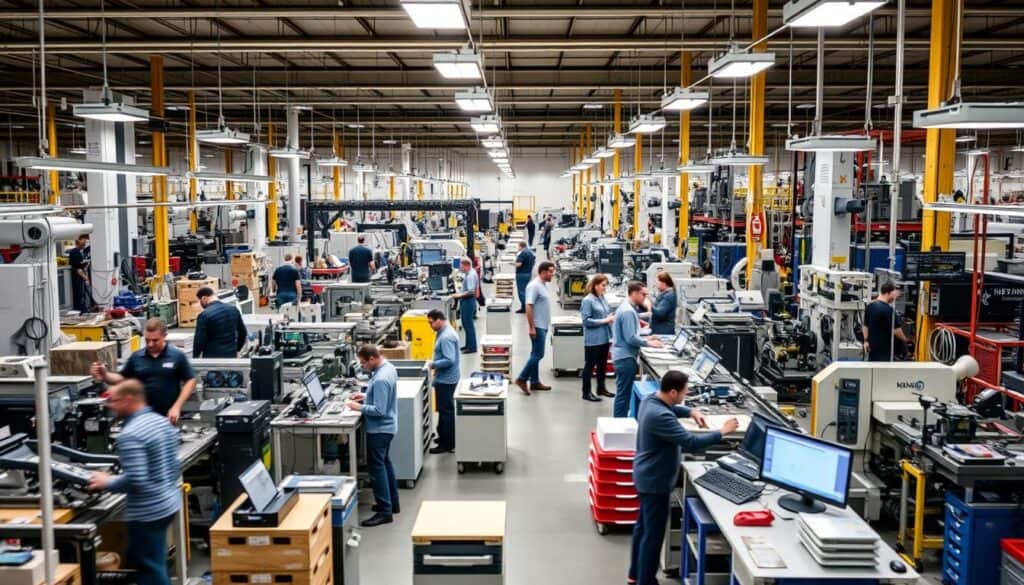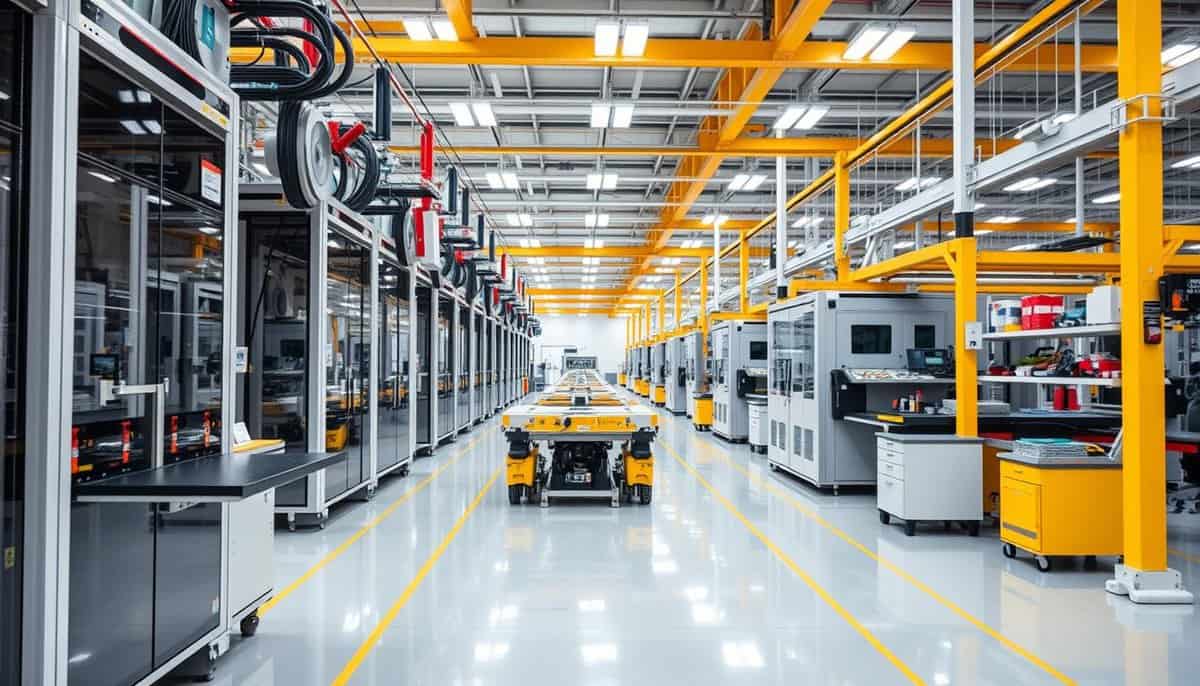Can a simple design change spark a revolution in productivity? The key might be in the Single Minute Exchange of Die (SMED) approach. This method goes beyond just cutting down on changeover times. It reshapes the very core of production efficiency. In the tough arena of manufacturing, where downtime takes a big chunk of the schedule, using SMED during design is crucial.
When implemented well, SMED can cut changeover times drastically, by 50% to even more than 90%. Picture a leading car maker reducing die change from 8 hours to only 15 minutes. That’s the impact of SMED-focused design. These improvements boost efficiency and support a culture of ongoing progress, enhancing success.
Key Takeaways
- Integrating SMED principles can dramatically cut changeover times, boosting overall equipment effectiveness by 15-25%.
- SMED system implementation supports smaller batches and just-in-time operations, reducing inventory costs.
- Designing with SMED in mind ensures long-term operational efficiency and reduces the need for costly future modifications.
- Standardizing changeover processes from the initial design stage fosters predictable and consistent production planning.
- Utilizing modular equipment design and quick-connect systems can significantly streamline manufacturing workflows.
What is SMED in Manufacturing?
The Single-Minute Exchange of Die (SMED) system was created by Shigeo Shingo. It greatly cuts down equipment setup times to under 10 minutes. This change has sparked a revolution in how factories operate. By changing internal tasks to external ones, setups become quicker and more efficient. The SMED process focuses on getting ready, splitting tasks, making things standard, and always getting better. This can cut down changeover times by up to 94%, changing how industries work.
Introduction to SMED
SMED stands for Single-Minute Exchange of Die, a new way to lower downtime in making things. Created by Shigeo Shingo, a famous Japanese engineer, it greatly cuts setup times. For example, changing a task from taking 90 minutes to under 5 minutes. The main goal of SMED is to make setups external instead of internal. This allows work to be done while machines are still running. By making changes faster, factories can quickly meet customer needs and keep less stock.
Key Components of SMED
To really understand SMED, you need to know its main parts. The first part is getting ready by organizing tools and materials ahead of time. This step, and getting things like extra jigs and making equipment modular, makes changeovers smooth and fast. The second part is about splitting tasks that are internal from those that are external. Internal tasks stop the machine, while external ones don’t. By doing more tasks externally, changeover times drop a lot. For instance, what took 90 minutes could now take less than 10 minutes. This boosts efficiency hugely.
Standardization is the third key part of SMED. It breaks tasks into small, repeatable steps. A changeover might list 30 to 50 steps involving both people and machines. Making things standard reduces differences. This keeps operations consistent. Plus, a cycle of continuous improvement, using feedback and training, keeps the system up-to-date. This keeps operations working their best over time.
SMED’s smart approach changes how a manufacturing unit works for the better. Focusing on machines that take a moderate time to changeover and workers who know those machines leads to successful SMED use. Factories losing over 20% of time due to changeovers are perfect for SMED. By using SMED, companies increase their capacity, can make smaller batches, and improve product quality. This shows how important this breakthrough idea is.
Benefits of SMED
SMED (Single-Minute Exchange of Dies) offers big benefits for making things. It aims to cut changeover times to under ten minutes. This leads to more production. Industries like medical, pharmaceutical, and tag and label greatly benefit from this.
Reduced Downtime
One big plus of SMED is the huge drop in downtime. By cutting setup times, factories make more and use machines better. It changes internal tasks to external ones. This makes setups quicker. For example, a pit crew got their changeover down from 67 seconds in 1950 to much less by 2013.

Increased Flexibility
SMED also makes manufacturing more flexible. It lets factories change their schedules faster to meet customer needs. This is really helpful for contract converters. They can do changeovers more often, which means they can make smaller batches of many products.
Cost Savings
SMED can save a lot of money in manufacturing. It means less machine downtime, which cuts costs and gives more space for making stuff. Also, keeping less stuff in stock and using fewer materials saves money. Imagine saving $0.50 on each part just from being more efficient.
Improved Quality
SMED also means better products with fewer mistakes. It makes every step of making something the same every time. This is super important for making things that need to be perfect, like in the medical field. Writing down how everything is done helps keep quality high.
Enhanced Employee Morale
Lastly, SMED helps workers feel better about their jobs. When work is smoother and less stressful, everyone is happier. Having steps written down makes jobs easier to do well. This ends up making the whole factory work better.
| Benefit | Description |
|---|---|
| Reduced Downtime | Minimizes setup time, increasing machine utilization and productivity. |
| Increased Flexibility | Allows frequent changeovers, supporting a varied production schedule. |
| Cost Savings | Lower production costs by reducing downtime, inventory levels, and material waste. |
| Improved Quality | Enhances product quality through process standardization and defect reduction. |
| Enhanced Employee Morale | Creates a less stressful work environment through efficient, documented procedures. |
Why SMED Should be Considered in the Design Phase
Starting with SMED principles early in manufacturing setup brings major benefits. Companies like Toyota show that design for SMED manufacturing radically cuts changeover times. This boosts production efficiency and saves costs.
Long-term Efficiency
Adopting SMED early leads to huge efficiency gains. Toyota slashed press changeover times from over ten hours to under ten minutes. This was thanks to process and equipment redesigns. These moves cut setup times and smooth production flows.
Cost Reduction
Designing with SMED cuts costs by reducing idle times and labor. A new large packaging facility needed fewer change-over times and only two people to run. This shows the cost and efficiency gains from smart setup time reduction and better production efficiency.
Operational Excellence
SMED is key for ongoing operational excellence. It uses advance prep, equipment tweaks, and standardizing to speed up changes. These steps boost consistency, quality, and cut manufacturing and inventory costs. Lean/Six Sigma followers will find SMED crucial for top operational efficiency.
Design for SMED Manufacturing
Designing for SMED manufacturing means planning with key SMED steps in mind for better results. This method focuses on...
You have read 33% of the article. The rest is for our community. Already a member? Log in
(and also to protect our original content from scraping bots)
Innovation.world community
Login or Register (100% free)
View the rest of this article and all members-only content and tools.
Only real engineers, manufacturers, designers, marketers professionals.
No bot, no hater, no spammer.
FAQ
What is SMED in Manufacturing?
SMED stands for Single Minute Exchange of Die. It’s a method aimed at cutting equipment setup times to under 10 minutes. The approach involves preparation, splitting tasks into those done while the machine is running and not, standardizing work, and always improving.
What are the key components of SMED?
SMED focuses on key steps like preparation and dividing tasks into internal and external. This means figuring out what can be done while machines run and what cannot. It leads to more efficient operations.
What are the main benefits of SMED?
Using SMED dramatically cuts downtime. It lets factories quickly switch between products, saving money and improving quality. It also makes jobs less stressful, boosting worker happiness.
Why should SMED be considered in the design phase?
Adding SMED early in design means big long-term savings and smoother operations. It makes sure equipment and processes are set up for fast changes right from the start.
How can SMED principles be integrated into design?
Designing with SMED in mind means separating setup tasks and making procedures standard. Using technology like modular equipment and automation helps make fast changes possible.
What strategies are effective for SMED implementation?
Good SMED strategies involve management buying in, using teams from different areas, trying out ideas in small tests, and teaching everyone involved.
What are some tips for designing for SMED?
Important tips include standardizing work, using versatile equipment, minimizing tasks done while machines are stopped, and using technology for faster setup. Encouraging teamwork and continuous feedback is key, too.
How do lean manufacturing and SMED complement each other?
Lean manufacturing and SMED both aim to cut waste and make things run smoother. SMED does this by focusing on reducing time lost to changing equipment. Together, they make factories more flexible and efficient.
What is the role of continuous improvement in SMED?
Continuous improvement is vital. It’s about always finding ways to do things better in SMED. This means regular check-ups and listening to feedback for even small improvements in setup times.
Can you provide examples of successful SMED implementation?
Many sectors, like auto, electronics, and consumer goods, have seen big benefits from SMED. They’ve slashed time to switch tasks and upped their ability to meet demand.
What are common challenges in implementing SMED?
Some challenges are employees who don’t want to change and not having enough training resources. Overcoming these issues takes good change management and making sure enough support is available.
Glossary of Terms Used
Computer Numerically Controlled (CNC): a manufacturing process that uses programmed computer software to control machine tools, enabling precise and automated operation for tasks such as cutting, milling, drilling, and engraving materials.
Network-attached storage (NAS): a storage device connected to a network that allows data access and sharing among multiple users and devices, typically providing centralized file storage, backup, and management capabilities. It operates independently of a computer and can be accessed via standard network protocols.
Overall Equipment Effectiveness (OEE): a metric used to evaluate the efficiency of manufacturing processes, calculated by multiplying availability, performance, and quality rates. It identifies losses, enabling improvements in productivity and operational effectiveness.
Single Minute Exchange of Dies (SMED): a lean manufacturing technique aimed at reducing equipment setup times to less than ten minutes, enabling quicker transitions between production runs and increasing overall efficiency by streamlining processes and minimizing downtime.



























Interesting read! Does anyone else think SMED might be a bit overrated compared to other Lean methodologies? Thoughts?
what about applications in emerging industries, such as renewable energy or tech startups ?
It would be helpful to include more about how companies can overcome the resistance to change, perhaps by sharing best practices or case studies where effective change management strategies led to successful SMED implementation.
Great article on the benefits of SMED! It might be helpful to also discuss how integrating SMED with digital tools like IoT and data analytics can further optimize setup times and enhance overall manufacturing efficiency.
Interesting read! But isnt there a blind spot in optimizing design for SMED without considering the impact on overall production quality?
Absolutely, SMED isnt the holy grail. Quality cant take a backseat in the race for efficiency!